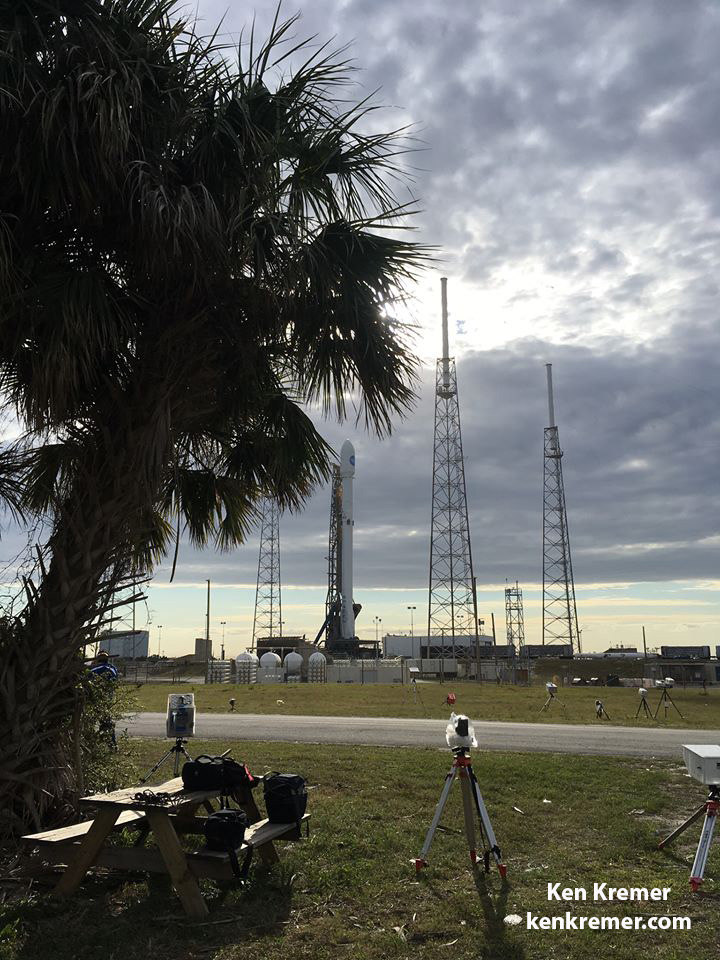FL – A SpaceX Falcon 9 rocket is poised for a thrilling overnight blastoff
tonight just moments after midnight on a mission to deliver the Hispasat 30W-6 telecomsat
for Spain to geosynchronous orbit on Tuesday March 6. IT will transmit HDTV,
DTV and highspeed internet to Spanish and Portuguese language countries in
Europe and South America.
to be a sky watching and space enthusiasts delight because the weather prognosis
is currently excellent and marks the 50th
Falcon 9 to be launched.
been raised erect to launch position today, Monday, March 5.
liftoff at 12:33 a.m. EST
(533 GMT, 633 Spanish time) from seaside Space Launch Complex-40 (SLC-40) on Cape Canaveral Air
Force Station.
satellite is encapsulated inside the payload fairing.
launches tonight, carrying Hispasat for Spain,” tweeted SpaceX CEO Elon Musk.
almost the size of a city bus, it will be the largest geostationary satellite
we’ve ever flown.
week from late February when a last minute issue arose with the fairing
pressurization mechanism, which has now been resolved.
30W-6 satellite will be put into space by a SpaceX Falcon 9 launcher from
Cape Canaveral Air Force Station in Florida, after the fairing’s pressurization
system incident was solved,” HISPASAT said in a statement released today.
Artists concept of Hispasat 30W-6
(70-meter-tall) SpaceX Falcon 9 rocket will deliver HispaSat 30W-6 to a
geosynchronous transfer orbit for HISPASAT – which is
“comprised of companies that have a presence in Spain as well as
in Latin America, where its Brazilian affiliate HISPAMAR is based.”
in the distribution and broadcasting of Spanish and Portuguese content, and its
satellite fleet is used by important direct-to-home television (DTH) and
high-definition television (HDTV) digital platforms, according to a company
description.
After reaching its initial orbit it will be moved to its final
orbital position, 30º West, where it will replace and broaden the capacity of
Hispasat 30W-4.
|
The SpaceX Falcon 9 rocket launching Hispasat30W6 is raised erect
at Space Launch Complex 40 on on Cape Canaveral Air Force Station, FL on March 5, 2018 ahead of midnight launch on March 6 in this distant view from Titusville, FL. Liftoff set for just past midnight at 12:33 am ET. Credit: Ken Kremer/SpaceUpClose.com/kenkremer.com |
launching Tuesday “was manufactured by Space Systems Loral in Palo Alto
(California) and involved the significant participation of the Spanish
aerospace industry.”
The bus sized satellite weighs 6 metric tons.
starting about 15 minutes prior to the 12:33 a.m. EST (533
GMT) liftoff time.
The launch will also be
streamed live on the HISPASAT and HISPAMAR webpages.
hours. The window opens at 1233 a.m. EST
(533 GMT)
and extends until closing at 2:33 a.m.
EST, or 733 GMT.
launch day is Wednesday, March 7, in case of any delay for weather or technical
reasons, but the weather outlook deteriorates significantly.
AF weather forecast on Tuesday is extremely favorable with a 90% chance of acceptable conditions at launch time. The
primary concern is for the Thick Cloud Layers rule.
Wednesday the chances plummet to only a 40% chance of acceptable conditions at
launch time due to rains.
double header of launches in the span of just over 4 days!
stunning dinnertime liftoff of the 20 story tall Atlas V rocket carrying the 5.5
ton GOES-S next generation weather observatory to geosynchronous orbit for NOAA
and NASA. Read out stories.
ULA, Boeing, Lockheed Martin, Orbital ATK and more space and mission
reports direct from the Kennedy Space Center and Cape Canaveral Air Force
Station, Florida.
Earth and Planetary science and human spaceflight news: www.kenkremer.com –www.spaceupclose.com –
twitter @ken_kremer – ken
at kenkremer.com






